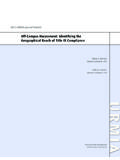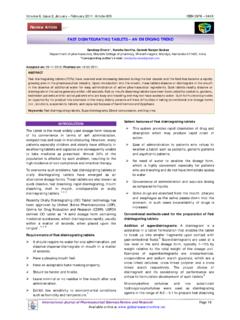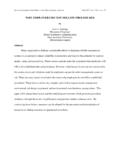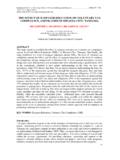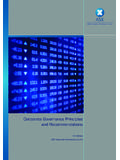Transcription of North Sea Offshore Authorities Forum Multi …
1 North Sea Offshore Authorities Forum Multi -National Audit Human and Organisational Factors in Well Control 2012 - 2013 Page 1 of 18 Page 2 of 18 CONTENTS 1. Executive Summary 2. Introduction 3. The Importance of Human and Organisational Factors in Well Control 4. The NSOAF Multi -National Audit 5. Control Panel/Engineering Systems Findings from the Audit 6. Human Factors Findings from the Audit 7. Organisational Factors and Company Interfaces Findings from the Audit Annex 1 Effective response to well control demands Annex 2 Audit questionnaire guidelinePage 3 of 18 influential in well control. 1. Executive Summary The Deepwater Horizon blowout at the Macondo well in 2010 was a salutary reminder to the worldwide Offshore industry of the need for exemplary standards of well control. Although that disaster happened thousands of miles away from Europe, the lessons from it are just as applicable for operators and drilling contractors in the North Sea.
2 The North Sea Offshore Authorities Forum1 (NSOAF), which consists of representatives of Authorities responsible for regulating Offshore activities in North West Europe, is therefore anxious that any findings from thatdisaster in the Gulf of Mexico be incorporated into the practises of those working under their jurisdictions. Although it is clear that considerable effort has been paid by the industry to address the operability of blowout preventers and the need for capping stacks for subsea wells, human and organisational factors have been identified as being equally As a result, members of NSOAF carried out a Multi -national audit (MNA) during 2013 to look at how the Offshore operators and drilling contractors in the North Sea are incorporating the wide range of necessary human and organisational factors into their well control systems. Eleven separate audits were carried out. This report describes the background to the audit, explains the relevance of the various issues that were considered, and summarises the conditions found from the eleven audits that were undertaken.
3 The results therefore provide a snapshot of well control standards in those topics across the North Sea, with clear identification of good and poor practises. NSOAF hopes that companies will reflect on the findings and use them in their continuous improvement process for these crucial aspects of Offshore safety and environmental protection. The good practises recorded in this report should prove to be easily adoptable by others in the industry The audit results supported the view that the industry was providing key well control personnel with clear and comprehensive ranges of relevant information, and with adequate designs of displays, control panels, alarm and data systems. Although there were some rigs where practises needed improvement, overall the control panel and associated engineering system aspects from the audit were good. Similarly, those aspects linked to how drilling personnel would be able to make the right judgement and decision on well control issues were good.
4 Encouragingly, the audit received strong assurance of the driller s authority to shut in wells when necessary. However, there was a broader range of performance here, and hence the need for those on the lower end to emulate the more advanced operators and drilling contractors, in particularly in the wider use of scenario-based training. The audit, though, identified a particular issue caused by the general shortage of experienced drilling personnel - the high activity level of the industry has contributed to accelerated promotions to key drilling positions, and there was widespread acknowledgement that this caused difficulty in securing adequate competence assurance programmes. This problem must not be ignored by industry Although there was evidence of an industry culture of close monitoring of performance-related KPIs, disappointingly the MNA saw none that were specifically focused on well control. Moreover, with the strong emphasis of penalising underperformance in areas of such rig utilisation, up time etc, the negative influence of such penalties in an environment where the early application of well control measures was ostensibly encouraged was not clear.
5 This potential for perversely (and negatively) influencing sound well control management did not seem to have been sufficiently addressed by the industry. There was only relatively weak evidence of how companies learn lessons from incidents, an area that has come under particular scrutiny since Macondo. Although most drilling contractors and their clients produced reports to learn from incidents, there was little to convince that those reports were receiving wider circulation or usage outside the constrained boundaries of the rig or platform in question, let alone spread wider within the industry. Lastly, a potentially major weakness identified by the audit was the quality of the interfacing arrangements. Given the fundamental need for the client operator, the drilling contractor, and the numerous specialist contractors to all operate as a unit, the lack of clarity in the various levels of bridging and interfacing documentation/processes was 1 NSOAF was created in 1987 and its membership is Denmark, Faroe Islands, Germany, Republic of Ireland, Netherlands, Norway, and the United Kingdom.
6 The Forum exists to: exchange information, examples of best practice and lessons learnt from incidents develop common positions and joint initiatives reduce the difficulties due to differences in regulatory regimes and requirements harmonise standards where possible Page 4 of 18 a real concern. In particular, the lack of effective gap analysis in the client and drilling contractor systems/documentation that the audit often found was of concern, and needs to be addressed. For instance, any lack of clarity over who has the ultimate responsibility for shutting in the well could lead to unacceptable delays for such a crucial decision. In conclusion, the audit found a range of approaches - some impressive, others less so - to the human and organisational factors in well control. The most worrying aspects of the audit results were those that covered issues relating to company systems and the way the various operators and their contractors interface.
7 NSOAF therefore commends this report to the North Sea Offshore industry, and asks that operators, their drilling contractors and their trade organisations take time to consider the various findings and to seek ways to implement the various good practises wider. NSOAF national regulators will be seeking opportunities to discuss the findings with their own national industry forums to ensure that the lessons learned about these crucial aspects of well control can be taken forward. Page 5 of 18 2. Introduction On 20 April 2010, a blowout at the Macondo well in the Gulf of Mexico resulted in an explosion and fire on the Deepwater Horizon drilling rig. Eleven Offshore workers lost their lives and another seventeen were injured. Hydrocarbons continued to flow from the reservoir for 87 days, with an estimated million barrels of oil causing significant environmental, economic and social damage.
8 The Deepwater Horizon disaster, coupled with the somewhat lower profile Montara blowout a few months earlier in the East Timor Sea North of Australia, gave rise to significant global concerns about the ability of the Offshore oil & gas industry to manage its safety and environmental risks effectively, particularly in well control. The North Sea, with over 500 oil & gas installations, has experienced severe Offshore accidents in the past, including the disasters involving Alexander Kielland (1980) and Piper Alpha (1988). Even though European countries have strict safety requirements and regulatory regimes for well design, construction and well control, the North Sea Offshore industry is not immune from the concerns arising from the Macondo and Montara blowouts. The experience of the Deepwater Horizon caused European regulators to reflect on whether their current regulatory frameworks and practices were adequate to control the major hazard risks of blowouts.
9 NSOAF considered the emerging findings from the investigations into both Macondo and Montara as information became available, including holding an extraordinary NSOAF Plenary meeting in December 2010. NSOAF concluded that considerable effort was being paid to address hardware failures such as the operability of blowout preventers (BOPs) and the need for capping stacks for subsea wells. However, NSOAF members were also concerned about the range of human and organisational factors that were being identified from both incidents as crucial aspects of well control2. As a result, NSOAF decided to carry out a Multi -national audit (MNA) specifically on human and organisational factors in relation to well control, involving a sample of operators, drilling contractors and service companies on installations in the North Sea during 2012/13. The aim of the MNA was to undertake a coordinated assessment across the North Sea of how the Offshore industry was focusing on human and organisational factors associated with well control, in order to identify current good practises and to help both industry and regulators learn lessons.
10 This report firstly explains the basis for the areas assessed by this MNA, and then describes the outcomes of this initiative. 2 At the time of preparing this NSOAF MNA report, the US Chemical Safety Board has yet to publish their findings of the Deepwater Horizon incident investigation, particularly organizational and human factors. However, when available, that report may also serve as an additional reference in order to underline the key observations of this audit. In the meantime, though, Professor Andrew Hopkins book Disastrous Decisions: the human and organizational causes of the Gulf of Mexico blowout, has been published, and he considers the realm of human and organizational factors that contributed to the disaster, going beyond previous commentary on this topic. He acknowledges that it is important to know what people did, but even more important to know why they did it. This book is therefore a good reference in the light of this audit.










